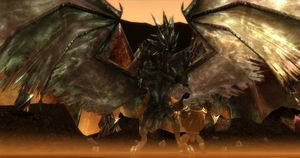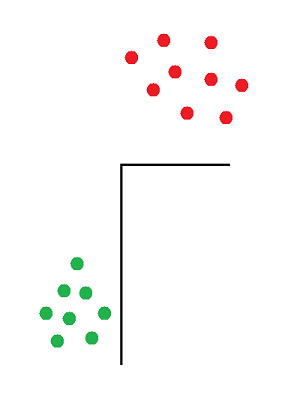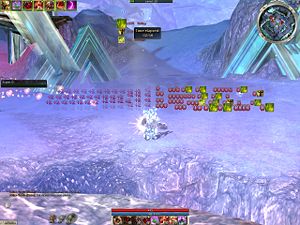Tank
Tanking is an "area denial" control-strategy in PvE in which a player deliberately exploits target fixation: that is, they draw-in the enemies’ attention (or “aggro”), and attempt to "ball them" with snares by making themself the sole focus of their attacks. The party member who performs this role is referred to as a tank.
General concepts[edit]
Tank players have one goal: to control space. They have to be intimidating, hard to move, and harder to defeat.
An effective tank-build must accomplish three objectives:
- Better Positioning: minimizing numerical advantages and identifying foe's mistakes for allies to exploit.
- Lockdown Area Denial: enhances team control and the effectiveness of area damage over time attacks.
- Damage Absorption: protects the rest of the party, who may be weaker and unable to withstand the enemies' attacks.
The ultimate goal of this strategy may vary according to both party member composition and the situation at hand. Tanking usually involves standing your ground, holding a powerful enemy (or a large group of enemies) in a confined spot while the rest of the party attacks and defeats it. The player who is acting as the tank generally does not contribute to the attack; the tank will no doubt be busy keeping themselves alive through snares and mitigating the incoming damage. A player that decides to tank must be capable of withstanding large amounts of damage, preferably without the aid of another party member.
Tanking takes advantage of a weakness in Foe behavior: when an enemy starts attacking a particular character, it usually doesn't stop until either it or its target is dead. In order for this weakness to be exploited, however, it is important that all other party members keep well outside of the enemy's Danger Zone-aggro range when a tank starts the attack. If the enemy finds an "easier to kill" character (i.e. lowered Health; weaker Armored) in range after the initial aggro, but before it is has committed attacking, it may ignore the tank and run for the easier to kill character.
Cornerblocking[edit]
When terrain is factored in, tanking is combined with another exploit in Foe behavior called cornerblocking, a concept identical to the protected flank Roman infantry tactics. Cornerblocking involves a player aggro'ing an enemy or group of enemies in such a way that the enemy tries to pursue, but is blocked by another player (or the same player) who is standing next to a wall or ravine. This strategy works because enemy AI does not understand how to properly circumnavigate players that are blocking their pathways. The enemies encounter this player, but since there is a wall on one side, they do not even try to get around, and so, they change targets and focus their attacks on the player standing in front of them. It is called "cornerblocking" because it works best when aggro'ing an enemy or group of enemies around a corner.
This strategy is generally unsuccessful in PvP, as experienced human players will focused on their primary target, san tactically ignoring better, weaker targets. Also, a human is obviously capable of navigating their character around most obstacles, while enemy AI has more problems with this. A human would also know when to flee (or, in circumstances where it would prove more advantageous, kite) if their health is getting dangerously low while, in general, enemy AI does not.
Setting up[edit]
There are many ways to tank. The classic tanks are Warrior characters, thanks to their very high Armor Rating, using skills that help to mitigate damage or to block attacks. However, there are many different ways to reach the same goal, so common tank builds use one of the following:
- A Warrior with high armor and defensive stances. The first kind of tank introduced in the game and still one of the most popular, Warriors have the best Armor Rating across all the professions, as well as being the only profession in the game that can utilize a Rune of Absorption, which greatly reduces incoming damage. Their stances can also be hard to remove, as few PvE enemies utilize stance-removing skills, skills like Defy Pain and Signet of Stamina can also be of great help. They are susceptible to elemental damage, but this weakness can be countered with spell-blockers like Obsidian Flesh and Spell Breaker. In high-level areas like The Deep, several Warriors are sometimes coordinated to build a wall between enemies and their party.
- A Dervish that relies on protective enchantments, such as the ones in Earth Prayers attribute. Dervishes usually rely on melee attacks, and so, like warriors, have skills that allow them to survive on the front lines. Although Warriors have the advantage of having Armor Ratings as high as 80, Dervishes can use enchantments and insignias that will raise their Armor Rating even higher. But because most of the Dervish's defenses are based on enchantments, they are more susceptible to enemies that use enchantment-removing skills, which is fairly common in PvE. However, the Mysticism attribute gives a minor boost to armor along with forms, flash enchantments, and teardowns granting benefits (such health and energy whenever an enchantment is removed). Coupled with skills like Mystic Sandstorm, enchantment removal can be a powerful weapon for a Dervish.
- An Elementalist that compensates for their low armor with strong, defensive Earth Magic spells. With weaker armor than Warriors and Dervishes, Elementalists are forced to rely even more on their spells than Dervishes, be it through enchantments (their most common defense) or through skills such as Ward Against Melee that may help the entire party. Elementalist tanks are found less often in PvE areas than Dervishes or Warriors, but they are often used in more specialized roles such as in the Domain of Anguish, or, in some farming areas.
- A Necromancer with a vast army of minions who specialize in melee attacks. Here, the Necromancer themself does not usually tank; rather, they create a large number of minions that block for the party, which are targeted by enemies. However, since minions are difficult to control, it is not easy to properly block approaching enemies. However, if a proper block can be established, skills like Death Nova, when cast on as many minions as possible, can create more corpses for the Necromancer to exploit and create more minions to sustain the block with.
- A Monk with special healing and protection skills can protect themselves and the group as a tank. Usually they use skills such as Protective Spirit and Spirit Bond because of their low Armor Rating of 60. However, due to the Monks' nature of healing and protecting other allies in the back of the party, it is rare to see monks tanking in any group situations. Monks running a 55 build can tank effectively, but they usually run solo and have no party to protect. Monks that tank often bring Smiting Prayers skills as a form of damage output.
- An Assassin using Shadow Form and Deadly Paradox or Glyph of Swiftness to reduce Shadow Form's recharge time. With Shadow Form's invincibility to spells and 5 damage reduction per enchantment on the Assassin, the Assassin will be a near-invincible tank while the rest of the team can do their work. With a simple chain that involves Death Blossom, the assassin can also keep aggro easily, if necessary.
- A pet is also another possible tank. Buffed with Call of Protection, Symbiotic Bond, Otyugh's Cry, and 33% damage reduction in PvE, it can easily make the single best damage absorber in the game; however, the opposing AI gives them less priority as a target, making them less reliable as tanks for large groups, especially if a delicate structure is in place and is snapped easily by faulty aggro.
Examples[edit]
- In the Underworld, a single Bladed Aatxe can deal up to 300 damage to casters. Using a tank to control the aggro is a basic tactic to surviving encounters with them and other heavy-hitting enemies in the Underworld, but party-wide damage mitigation leads to far faster clears.
- In these end-game elite areas, tanks may choose to fully give up their damage-dealing capabilities and take advantage of Earth Magic defensive capabilities (the key skill usually being Obsidian Flesh) coupled with defensive stances to provide an even more durable tank. Of course, such a role is best suited for well-coordinated teams that understand the respective roles each party member need to play.
 Bond tank[edit]
Bond tank[edit]
See PvXwiki's Mo/any Spirit Bonder Farmer page
 Perma tank[edit]
Perma tank[edit]
- See also: Perma Shadow Form
|
Shadow Arts: 12+1+3 Wilderness Survival: 12 Deadly Arts: 3 | ||||||||
A perma tank (or SF tank) utilizes a permanent Shadow Form to gain immunity to harmful spells. It has lower energy costs than a Terra tank, but misses the multitude of powerful defensive enchantments of Earth Magic.
- Equipment
With a 33% skill recharge reduction, a weapon of Enchanting and 12 ranks in Shadow Arts, any profession with enough energy reserves is able to keep up Shadow Form permanently. Primary assassins have more freedom of choice (see Perma Shadow Form - Setup). The effects of any equipment which benefits from enchantments, such as Blessed Insignia or Sheltered by Faith can be reliably maintained.
- Skills
To keep Shadowform permanently active, skills such as Deadly Paradox or consumables that reduce recharge time are needed. Since Shadow Form only marginally protects from attacks by itself, it is often combined with Shroud of Distress for blocking and additional damage reduction. Additional defensive skills may include healing, higher block chances, extra armor, or more damage reduction, depending on enemy skills.
 Stance tank[edit]
Stance tank[edit]
|
Tactics: 12+1+1 Strength: 12+1 | ||||||||
Stance tank is a less common type of PvE tank build which heavily - as the name implies - relies on stances to survive. Stance tanks are mostly primary Warriors or Rangers and in case of the latter secondary warriors. Stance tank builds are meant to draw, hold and survive dangerous groups of physical attackers and damage dealers, while either inflicting damage through their weapons or punishment skills. Mostly, they are used to solo farm melee attackers.
- Equipment
Stance tanks usually rely on equipment which benefit from being in a stance, such as shields of Endurance.
- Skills
Warrior stance tanks rely on Tactics stances, such as Auspicious Parry and Gladiator's Defense in addition to stance-like skills like Deadly Riposte and Riposte, for their typical combination of defense and damage. Dolyak Signet is commonly used to reduce damage taken even further and prevent knock downs.
Ranger stance tanks mostly utilize Dryder's Defenses, Lightning Reflexes, or Whirling Defense in combination with instant-recharge skills like Oath Shot or"On Your Knees!" to stay alive.
 Terra tank[edit]
Terra tank[edit]
Terra tank builds which relies on Earth Magic enchantments to either designed to draw, hold and survive heavy aggro while nukers kill their attackers, or to survive heavy aggro while using skills such as Sliver Armor to inflict damage back to foes.
- Equipment
A weapon of Enchanting and Geomancer Insignia are generally used. A shield or off-hand with +10 armor vs earth damage can also be used for further damage reduction.
- Skills
Terra tank builds rely on Earth Magic enchantments, such as Armor of Earth, Obsidian Flesh and Stoneflesh Aura for defense. Glyph of Concentration is commonly used to prevent interruption and Grasping Earth is commonly used as a snare.
A Mesmer secondary profession is often used, utilizing Mantra of Earth and Stone Striker for more damage reduction and to make up for the energy degeneration of Obsidian Flesh.
See also[edit]
External links[edit]
| Team roles (edit) | ||||
|---|---|---|---|---|
| Type | General team roles | Specific team roles | Hero team roles | |
| Damage | Spiker • Nuker | Bomber • Dagger spammer • Touch ranger • Starburster • Trapper | — | |
| Pressure | Lineback | Barrager • Beast master • Cripshot Ranger • Pressure Ranger | — | |
| Support | Healer • Protection | Battery • Bonder • Flag runner • Hybrid monk • Imbagon • Infuser • Orders | — | |
| Control | Shutdown • Tank | Minion master • Perma • Spirit spammer | Mesmer Midline | |
| Utility | Caller • Toolbox | Gimmick | — | |

























